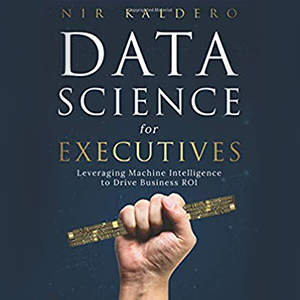
The Data-Driven Leader: Why You Should Always Ask for the Data When Making Decisions
By Nir Kaldero
How do you usually make decisions? Are you a shoot-from-the-hip kind of leader, who thinks best on their feet and tends to know the right decision to take intuitively? Alternatively, perhaps you’re someone who likes to consult with a team, develop a consensus, and move forward when everyone agrees. A third possibility is that you like to consider all the options in a meditative fashion, only to move forward when you feel comfortable that you’ve chosen the right one.
The role of the leader is changing. In the twenty-first century, one of the primary roles of the business leader is to champion data. Why? Because the Fourth Industrial Revolution is already upon us, and organizations that don’t adapt will soon fall by the wayside.
The First Industrial Revolution was about steam and railroads, the Second about electricity, and the Third brought about by the Internet. Artificial Intelligence, the basis of the Fourth Industrial Revolution, will completely change the way business is done and companies are run in the next five to ten years, just as the Internet has done in the last ten. The transformation will be bigger than that any previous revolution has brought about. To compete in the new landscape of the Fourth Industrial Revolution, organizations will be required to drive value by leveraging the vast amount of data they already possess with sophisticated machine-intelligence modeling techniques.
As a leader, you need to set your employees an example of a data-first approach. Every time they make a suggestion or recommendation that can lead or contribute to a decision or outcome, you must ask them for the data that supports their recommendations. Hold them accountable. Always get people to show you the data before you make a decision or come to a conclusion.
When you model this data-first approach, you will drive more data-driven decision-making throughout the organization. I always tell executives, “Listen, you are a group of twenty-five people managing 65,000 people or more. Start to ask the people you manage for data.” This creates a positive feedback loop that amplifies the approach. Your team will go from asking for data once a day to looking at data a hundred times a day. If a top executive asks her direct reports for data, her voice will be amplified throughout the organization as they ask their direct reports for data as well.
Champion a Data-Driven Mindset
As one of the leaders of your organization, you can play a significant role in encouraging people throughout the company to use data to drive their decisions. When people see you using and requesting data, they will begin to do the same. This is how you can start embedding the data-driven mindset into your corporate culture. Make sure your employees have reviewed the data and can adequately explain their decisions, recommendations, and options before they come to you.
Another important role for twenty-first-century business leaders is applying machine-intelligence techniques and a data-driven mindset horizontally. What does this mean? Imagine that you have solved a problem, such as predictive maintenance for warehouse equipment. Okay, now you can ask yourself whether you can apply the same solutions to consumer products. Maybe the data involved is similar. Within the same organization, user behavior patterns will be similar enough that previous learning can be applied. Diffusing machine intelligence horizontally through different parts of the organization can leverage its predictive power.
Chances are data between companies will be quite distinct, so reusing learning in different verticals outside the organization is unlikely. Nonetheless, let’s say that Amazon builds a predictive maintenance model for its warehouses. Perhaps the company can extend predictive maintenance to the vehicles that interact with the warehouses, and so on throughout the ecosystem.
Continue to Iterate and Learn
Taking an active role in using and requesting data is a good start. With the capacities of machine learning growing so quickly, however, you also need to constantly refine your data strategy. You must focus not only on the technology required to pull data from different systems within the organization but also on data availability and acquisition. You can’t just create a strategy for leveraging data. To add ROI, you also have to think about data availability, accessibility, acquisition, and labeling. Data governance also plays a major strategic role.
Because data science changes so quickly, business leaders must keep learning. Machine intelligence is a fast-growing field, evolving right now, even as you are reading. You should familiarize yourself with the capabilities of today’s tools and where short-term advantages are likely to occur. But also get a sense of where the field is heading and develop a perspective on what the longer-term future might look like for your organization. Be curious, adopt an agile mindset, and stay tuned in to trends in this rapidly evolving industry.
As this cultural transformation spreads through your organization, you will gradually see it become more and more data-driven. That will spread throughout your company until it becomes second nature for everyone to base their decisions on data.
- - -
For more advice on becoming a data-driven leader, you can find Data Science For Executives on Amazon.
Nir Kaldero is dedicated to bringing the benefits of data science and machine intelligence into business. As the head of data science at Galvanize, Inc., he has trained numerous C-Suite executives from Fortune 200 companies in how to transform their companies into data-driven organizations by applying the technology behind the “fourth industrial revolution.”


